LINK
-
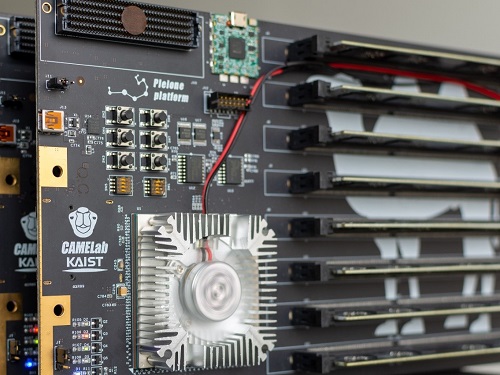 CXL-Based Memory Disaggregation Technology Opens Up a New Direction for Big Data Solution Frameworks
A KAIST team’s compute express link (CXL) provides new insights on memory disaggregation and ensures direct access and high-performance capabilities
A team from the Computer Architecture and Memory Systems Laboratory (CAMEL) at KAIST presented a new compute express link (CXL) solution whose directly accessible, and high-performance memory disaggregation opens new directions for big data memory processing. Professor Myoungsoo Jung said the team’s technology significantly improves performance compared to existing remote direct memory access (RDMA)-based memory disaggregation.
CXL is a peripheral component interconnect-express (PCIe)-based new dynamic multi-protocol made for efficiently utilizing memory devices and accelerators. Many enterprise data centers and memory vendors are paying attention to it as the next-generation multi-protocol for the era of big data.
Emerging big data applications such as machine learning, graph analytics, and in-memory databases require large memory capacities. However, scaling out the memory capacity via a prior memory interface like double data rate (DDR) is limited by the number of the central processing units (CPUs) and memory controllers. Therefore, memory disaggregation, which allows connecting a host to another host’s memory or memory nodes, has appeared.
RDMA is a way that a host can directly access another host’s memory via InfiniBand, the commonly used network protocol in data centers. Nowadays, most existing memory disaggregation technologies employ RDMA to get a large memory capacity. As a result, a host can share another host’s memory by transferring the data between local and remote memory.
Although RDMA-based memory disaggregation provides a large memory capacity to a host, two critical problems exist. First, scaling out the memory still needs an extra CPU to be added. Since passive memory such as dynamic random-access memory (DRAM), cannot operate by itself, it should be controlled by the CPU. Second, redundant data copies and software fabric interventions for RDMA-based memory disaggregation cause longer access latency. For example, remote memory access latency in RDMA-based memory disaggregation is multiple orders of magnitude longer than local memory access.
To address these issues, Professor Jung’s team developed the CXL-based memory disaggregation framework, including CXL-enabled customized CPUs, CXL devices, CXL switches, and CXL-aware operating system modules. The team’s CXL device is a pure passive and directly accessible memory node that contains multiple DRAM dual inline memory modules (DIMMs) and a CXL memory controller. Since the CXL memory controller supports the memory in the CXL device, a host can utilize the memory node without processor or software intervention. The team’s CXL switch enables scaling out a host’s memory capacity by hierarchically connecting multiple CXL devices to the CXL switch allowing more than hundreds of devices. Atop the switches and devices, the team’s CXL-enabled operating system removes redundant data copy and protocol conversion exhibited by conventional RDMA, which can significantly decrease access latency to the memory nodes.
In a test comparing loading 64B (cacheline) data from memory pooling devices, CXL-based memory disaggregation showed 8.2 times higher data load performance than RDMA-based memory disaggregation and even similar performance to local DRAM memory. In the team’s evaluations for a big data benchmark such as a machine learning-based test, CXL-based memory disaggregation technology also showed a maximum of 3.7 times higher performance than prior RDMA-based memory disaggregation technologies.
“Escaping from the conventional RDMA-based memory disaggregation, our CXL-based memory disaggregation framework can provide high scalability and performance for diverse datacenters and cloud service infrastructures,” said Professor Jung. He went on to stress, “Our CXL-based memory disaggregation research will bring about a new paradigm for memory solutions that will lead the era of big data.”
-Profile: Professor Myoungsoo Jung Computer Architecture and Memory Systems Laboratory (CAMEL)http://camelab.org School of Electrical EngineeringKAIST
2022.03.16 View 24208
CXL-Based Memory Disaggregation Technology Opens Up a New Direction for Big Data Solution Frameworks
A KAIST team’s compute express link (CXL) provides new insights on memory disaggregation and ensures direct access and high-performance capabilities
A team from the Computer Architecture and Memory Systems Laboratory (CAMEL) at KAIST presented a new compute express link (CXL) solution whose directly accessible, and high-performance memory disaggregation opens new directions for big data memory processing. Professor Myoungsoo Jung said the team’s technology significantly improves performance compared to existing remote direct memory access (RDMA)-based memory disaggregation.
CXL is a peripheral component interconnect-express (PCIe)-based new dynamic multi-protocol made for efficiently utilizing memory devices and accelerators. Many enterprise data centers and memory vendors are paying attention to it as the next-generation multi-protocol for the era of big data.
Emerging big data applications such as machine learning, graph analytics, and in-memory databases require large memory capacities. However, scaling out the memory capacity via a prior memory interface like double data rate (DDR) is limited by the number of the central processing units (CPUs) and memory controllers. Therefore, memory disaggregation, which allows connecting a host to another host’s memory or memory nodes, has appeared.
RDMA is a way that a host can directly access another host’s memory via InfiniBand, the commonly used network protocol in data centers. Nowadays, most existing memory disaggregation technologies employ RDMA to get a large memory capacity. As a result, a host can share another host’s memory by transferring the data between local and remote memory.
Although RDMA-based memory disaggregation provides a large memory capacity to a host, two critical problems exist. First, scaling out the memory still needs an extra CPU to be added. Since passive memory such as dynamic random-access memory (DRAM), cannot operate by itself, it should be controlled by the CPU. Second, redundant data copies and software fabric interventions for RDMA-based memory disaggregation cause longer access latency. For example, remote memory access latency in RDMA-based memory disaggregation is multiple orders of magnitude longer than local memory access.
To address these issues, Professor Jung’s team developed the CXL-based memory disaggregation framework, including CXL-enabled customized CPUs, CXL devices, CXL switches, and CXL-aware operating system modules. The team’s CXL device is a pure passive and directly accessible memory node that contains multiple DRAM dual inline memory modules (DIMMs) and a CXL memory controller. Since the CXL memory controller supports the memory in the CXL device, a host can utilize the memory node without processor or software intervention. The team’s CXL switch enables scaling out a host’s memory capacity by hierarchically connecting multiple CXL devices to the CXL switch allowing more than hundreds of devices. Atop the switches and devices, the team’s CXL-enabled operating system removes redundant data copy and protocol conversion exhibited by conventional RDMA, which can significantly decrease access latency to the memory nodes.
In a test comparing loading 64B (cacheline) data from memory pooling devices, CXL-based memory disaggregation showed 8.2 times higher data load performance than RDMA-based memory disaggregation and even similar performance to local DRAM memory. In the team’s evaluations for a big data benchmark such as a machine learning-based test, CXL-based memory disaggregation technology also showed a maximum of 3.7 times higher performance than prior RDMA-based memory disaggregation technologies.
“Escaping from the conventional RDMA-based memory disaggregation, our CXL-based memory disaggregation framework can provide high scalability and performance for diverse datacenters and cloud service infrastructures,” said Professor Jung. He went on to stress, “Our CXL-based memory disaggregation research will bring about a new paradigm for memory solutions that will lead the era of big data.”
-Profile: Professor Myoungsoo Jung Computer Architecture and Memory Systems Laboratory (CAMEL)http://camelab.org School of Electrical EngineeringKAIST
2022.03.16 View 24208 -
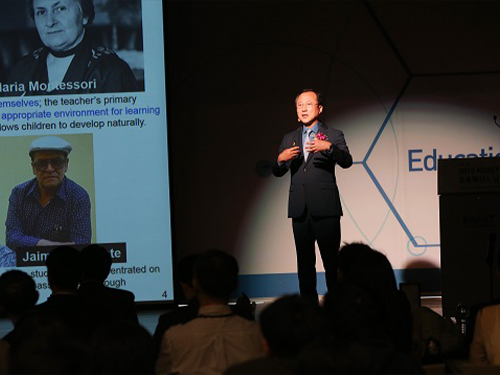 Education Innovation Day Reaffirms Rewarding of Excellence
Professors Tae-Eog Lee and Il-Chul Moon from the Department of Industrial & Systems Engineering received the Linkgenesis Best Teacher Award and the Soo-Young Lee Teaching Innovation Award on May 10. They were each awarded with 10 million KRW in prize money during the Education Innovation Day ceremony held at the Chung Kun-mo conference hall.
The award was endowed by KAIST Alumni Scholarship Chairman Hyung-Kyu Lim and KAIST Foundation Chairman Soo-Young Lee to support the innovation initiative and acknowledge faculty members who made significant contributions to educational innovation and benefited the general public though their innovations.
“KAIST’s vision for excellence and commitment to innovation is a game changer. Educational innovation is one of five pillars of Vision 2031, and it is our priority to foster critical and creative thinking students,” said President Sung-Chul Shin at the ceremony. All the awardees made presentation on their innovative projects and shared their ideas on better pedagogical methodology for next generation.
Professor Lee, dean of the KAIST Academy and the head of the Center for Excellence in Learning & Teaching was recognized for his contribution to enhancing educational quality through innovative learning and teaching methodology development. He has set up an Education 3.0 Initiative, an online education platform for flipped learning at KAIST.
Professor Moon also upgraded the online education platform to the 4.0 version and extended KAIST’s massive online courses through KOOC framework. This open platform offers more than 62 courses, with more than 170 thousand users registered since 2014.
Professor Song-Hong Park from the Department of Bio and Brain Engineering and Professor Jae-Woo Lee from the Department of Chemical and Biomolecular Engineering also won the Excellence Award.
2019.05.10 View 10196
Education Innovation Day Reaffirms Rewarding of Excellence
Professors Tae-Eog Lee and Il-Chul Moon from the Department of Industrial & Systems Engineering received the Linkgenesis Best Teacher Award and the Soo-Young Lee Teaching Innovation Award on May 10. They were each awarded with 10 million KRW in prize money during the Education Innovation Day ceremony held at the Chung Kun-mo conference hall.
The award was endowed by KAIST Alumni Scholarship Chairman Hyung-Kyu Lim and KAIST Foundation Chairman Soo-Young Lee to support the innovation initiative and acknowledge faculty members who made significant contributions to educational innovation and benefited the general public though their innovations.
“KAIST’s vision for excellence and commitment to innovation is a game changer. Educational innovation is one of five pillars of Vision 2031, and it is our priority to foster critical and creative thinking students,” said President Sung-Chul Shin at the ceremony. All the awardees made presentation on their innovative projects and shared their ideas on better pedagogical methodology for next generation.
Professor Lee, dean of the KAIST Academy and the head of the Center for Excellence in Learning & Teaching was recognized for his contribution to enhancing educational quality through innovative learning and teaching methodology development. He has set up an Education 3.0 Initiative, an online education platform for flipped learning at KAIST.
Professor Moon also upgraded the online education platform to the 4.0 version and extended KAIST’s massive online courses through KOOC framework. This open platform offers more than 62 courses, with more than 170 thousand users registered since 2014.
Professor Song-Hong Park from the Department of Bio and Brain Engineering and Professor Jae-Woo Lee from the Department of Chemical and Biomolecular Engineering also won the Excellence Award.
2019.05.10 View 10196 -
 KAIST, First to Win the Cube Satellite Competition
Professor Hyochoong Bang from the Department of Aerospace Engineering and his team received the Minister of Science and ICT Award at the 1st Cube Satellite Competition.
The team actually participated in the competition in 2012, but it took several years for the awarding ceremony since it took years for the satellites to be designed, produced, and launched.
The KAIST team successfully developed a cube satellite, named ‘Little Intelligent Nanosatellite of KAIST (LINK)’ and completed its launch in April 2017.
LINK (size: 20cmx10cmx10cm, weight: 2kg) mounted mass spectrometry and Langmuir probe for Earth observation. The Langmuir probe was developed by Professor Kyoung Wook Min from the Department of Physics, KAIST.
Yeerang Lim, a PhD student from the Department of Aerospace Engineering said, “I still remember the feeling that I had on the day when LINK launched into orbit and sent back signals. I hope that space exploration is not something far away but attainable for us in near future.”
2018.02.22 View 13056
KAIST, First to Win the Cube Satellite Competition
Professor Hyochoong Bang from the Department of Aerospace Engineering and his team received the Minister of Science and ICT Award at the 1st Cube Satellite Competition.
The team actually participated in the competition in 2012, but it took several years for the awarding ceremony since it took years for the satellites to be designed, produced, and launched.
The KAIST team successfully developed a cube satellite, named ‘Little Intelligent Nanosatellite of KAIST (LINK)’ and completed its launch in April 2017.
LINK (size: 20cmx10cmx10cm, weight: 2kg) mounted mass spectrometry and Langmuir probe for Earth observation. The Langmuir probe was developed by Professor Kyoung Wook Min from the Department of Physics, KAIST.
Yeerang Lim, a PhD student from the Department of Aerospace Engineering said, “I still remember the feeling that I had on the day when LINK launched into orbit and sent back signals. I hope that space exploration is not something far away but attainable for us in near future.”
2018.02.22 View 13056 -
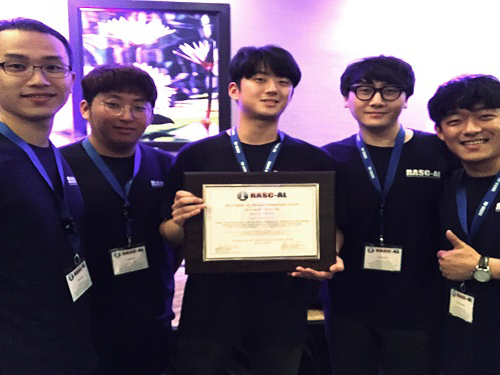 Winning Best in Theme Award in NASA RASC-AL
A students team from the Department of Aerospace Engineering won the Best in Theme Award for moon exploration system design at Revolutionary Aerospace Systems Concepts - Academic Linkage (RASC-AL), an aerospace mission system design competition organized by NASA in the USA.
The KAIST team, consisting of Jaeyoul Ko, Jongeun Suh, Juseong Lee, Sukmin Choi, and Eunkwang Lee, and supervised by Professor Jaemyung Ahn, competed as a joint team with Texas Tech University and the Royal Melbourne Institute of Technology in Australia,
The joint team was selected as one of the 14 finalists after two preliminary rounds. The finals of RASC-AL Forum took place from May 30 to June 3 in Florida. The team received the top prize with their design entitled ‘Earth to Lunar Interchangeable Transportation Environment (ELITE) for Logistics Delivery Systems’, one of the four themes of the competition.
Since 2002, RASC-AL competitions, managed by NASA, have been held with themes on innovative aerospace system and missions, in which world-class undergraduate and graduate students have participated.
This year’s themes were ▲ Lightweight Exercise Suite ▲ Airlock Design ▲ Commercially Enabled LEO/Mars Habitable Module and ▲ Logistics Delivery System.
Moon exploration requires a great deal of time and supplies. The KAIST team has been researching supply delivery systems in space for long-term manned moon exploration with their joint team for the last eight months. In particular, incidents can occur during the initial stages of long-term manned moon exploration missions that are unpredictable during system design and planning. Therefore, to cope with such unpredictability in the mission, the KAIST team deduced a system and an operational concept with increased flexibility to maximize the cost effectiveness of the supply transport.
The spacecraft was divided into propulsion and transport modules based on their functionalities, and can allow the flexibility by switching the transport module according to the demands of the moon base. The operational flexibility and cost effectiveness are further increased by introducing multiple departure orbits from the Earth (e.g. low Earth orbit vs. geosynchronous Earth orbit) enabled by utilization of various launch vehicles.
Professor Ahn, the advisor for the team, said, “I am proud of the students who collaborated with the international joint teams and achieved great result.” He continued, “I believe this to be the result of continuous efforts and initiatives of the department for system design-centered education. We will keep providing high-quality system design and education through various opportunities such as international cooperation in design education.”
(Photo caption: KAIST team of the Department of Aerospace Engineering poses after winning the Best in Theme Award in NASA's RASC-AL)
2017.06.22 View 10349
Winning Best in Theme Award in NASA RASC-AL
A students team from the Department of Aerospace Engineering won the Best in Theme Award for moon exploration system design at Revolutionary Aerospace Systems Concepts - Academic Linkage (RASC-AL), an aerospace mission system design competition organized by NASA in the USA.
The KAIST team, consisting of Jaeyoul Ko, Jongeun Suh, Juseong Lee, Sukmin Choi, and Eunkwang Lee, and supervised by Professor Jaemyung Ahn, competed as a joint team with Texas Tech University and the Royal Melbourne Institute of Technology in Australia,
The joint team was selected as one of the 14 finalists after two preliminary rounds. The finals of RASC-AL Forum took place from May 30 to June 3 in Florida. The team received the top prize with their design entitled ‘Earth to Lunar Interchangeable Transportation Environment (ELITE) for Logistics Delivery Systems’, one of the four themes of the competition.
Since 2002, RASC-AL competitions, managed by NASA, have been held with themes on innovative aerospace system and missions, in which world-class undergraduate and graduate students have participated.
This year’s themes were ▲ Lightweight Exercise Suite ▲ Airlock Design ▲ Commercially Enabled LEO/Mars Habitable Module and ▲ Logistics Delivery System.
Moon exploration requires a great deal of time and supplies. The KAIST team has been researching supply delivery systems in space for long-term manned moon exploration with their joint team for the last eight months. In particular, incidents can occur during the initial stages of long-term manned moon exploration missions that are unpredictable during system design and planning. Therefore, to cope with such unpredictability in the mission, the KAIST team deduced a system and an operational concept with increased flexibility to maximize the cost effectiveness of the supply transport.
The spacecraft was divided into propulsion and transport modules based on their functionalities, and can allow the flexibility by switching the transport module according to the demands of the moon base. The operational flexibility and cost effectiveness are further increased by introducing multiple departure orbits from the Earth (e.g. low Earth orbit vs. geosynchronous Earth orbit) enabled by utilization of various launch vehicles.
Professor Ahn, the advisor for the team, said, “I am proud of the students who collaborated with the international joint teams and achieved great result.” He continued, “I believe this to be the result of continuous efforts and initiatives of the department for system design-centered education. We will keep providing high-quality system design and education through various opportunities such as international cooperation in design education.”
(Photo caption: KAIST team of the Department of Aerospace Engineering poses after winning the Best in Theme Award in NASA's RASC-AL)
2017.06.22 View 10349 -
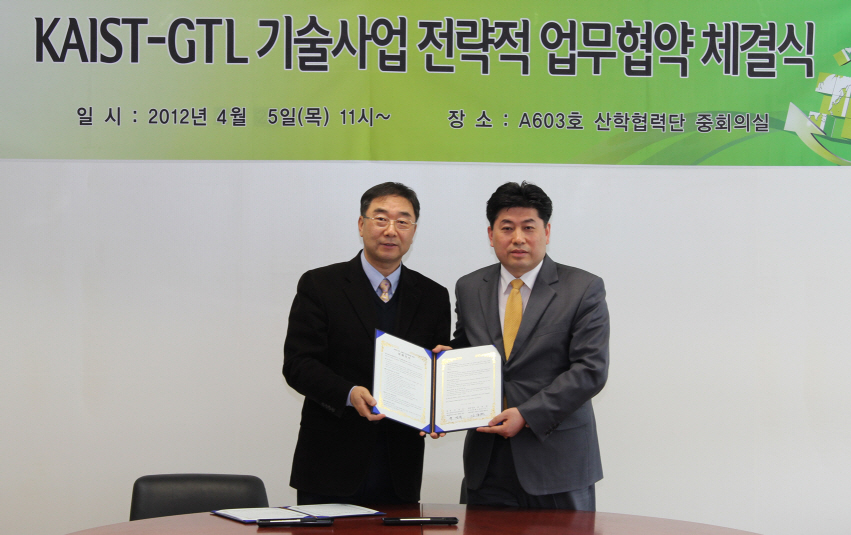 KAIST signs strategic partnership with Global Techlink
On April 5th, KAIST signed an official strategic partnership with Global Techlink (GTL), an IP total service company that specializes in international patents and the technology trade, regarding the commercialization of technology (Tech-biz) at KAIST’s Munji Campus.
Through this partnership, KAIST hopes to systematically manage not only patents and related technologies developed by the KAIST faculty, but also industrial developments based on business models.
Until now, KAIST has concentrated on using its own human resources to transfer its patents and technologies to domestic companies. However, this agreement with GTL allows KAIST to target overseas tech-biz markets.
GTL has agreed to help create, protect and strengthen patent rights stemming from KAIST’s research projects and ideas, as well as provide a unified management service extending from selling and licensing patents to venture incubation.
KAIST’s vice-president of research, Professor Paik Kyung-Wook said that “We should protect patents developed by talented students and use them in the market to generate profit, but the fact of the matter is that universities do not have the necessary man power or know-how to do so”. He emphasized that this partnership with GTL will accelerate the global commercialization of technological assets developed by KAIST professors, students and researchers.
Mr. Kim Jong-hyun, the president of Global Techlink, announced that GTL will provide KAIST’s outstanding intellectual property with a customized total consulting service based on the world’s largest and best technology database, which it monopolizes, and various other services. Also, using its network with global corporations and distributors, the veteran marketing specialists at GTL will support and carry out KAIST’s tech-biz, although the specifics are still being worked out.
2012.04.19 View 9653
KAIST signs strategic partnership with Global Techlink
On April 5th, KAIST signed an official strategic partnership with Global Techlink (GTL), an IP total service company that specializes in international patents and the technology trade, regarding the commercialization of technology (Tech-biz) at KAIST’s Munji Campus.
Through this partnership, KAIST hopes to systematically manage not only patents and related technologies developed by the KAIST faculty, but also industrial developments based on business models.
Until now, KAIST has concentrated on using its own human resources to transfer its patents and technologies to domestic companies. However, this agreement with GTL allows KAIST to target overseas tech-biz markets.
GTL has agreed to help create, protect and strengthen patent rights stemming from KAIST’s research projects and ideas, as well as provide a unified management service extending from selling and licensing patents to venture incubation.
KAIST’s vice-president of research, Professor Paik Kyung-Wook said that “We should protect patents developed by talented students and use them in the market to generate profit, but the fact of the matter is that universities do not have the necessary man power or know-how to do so”. He emphasized that this partnership with GTL will accelerate the global commercialization of technological assets developed by KAIST professors, students and researchers.
Mr. Kim Jong-hyun, the president of Global Techlink, announced that GTL will provide KAIST’s outstanding intellectual property with a customized total consulting service based on the world’s largest and best technology database, which it monopolizes, and various other services. Also, using its network with global corporations and distributors, the veteran marketing specialists at GTL will support and carry out KAIST’s tech-biz, although the specifics are still being worked out.
2012.04.19 View 9653 -
 The Irish Times: Gene link identified in ADHD, April 18, 2011
The Irish Times wrote an article on the recent research breakthrough made by a KAIST research team to identify a gene that triggers the syndrome of Attention Deficit Hyperactivity Disorder (ADHD) among children. Given the heightened attention to the syndrome across the world, the research result has received a great deal of attention not only from the academia but also from the media and public.
For the article, please visit http://www.irishtimes.com/newspaper/ireland/2011/0418/1224294910305.html. The research paper was appeared online April 17, 2011 in Nature Medicine, which will be printed in its May 2011 issue. For the paper, please click the link of http://www.nature.com/nm/journal/vaop/ncurrent/full/nm.2330.html.
2011.04.18 View 11167
The Irish Times: Gene link identified in ADHD, April 18, 2011
The Irish Times wrote an article on the recent research breakthrough made by a KAIST research team to identify a gene that triggers the syndrome of Attention Deficit Hyperactivity Disorder (ADHD) among children. Given the heightened attention to the syndrome across the world, the research result has received a great deal of attention not only from the academia but also from the media and public.
For the article, please visit http://www.irishtimes.com/newspaper/ireland/2011/0418/1224294910305.html. The research paper was appeared online April 17, 2011 in Nature Medicine, which will be printed in its May 2011 issue. For the paper, please click the link of http://www.nature.com/nm/journal/vaop/ncurrent/full/nm.2330.html.
2011.04.18 View 11167 -
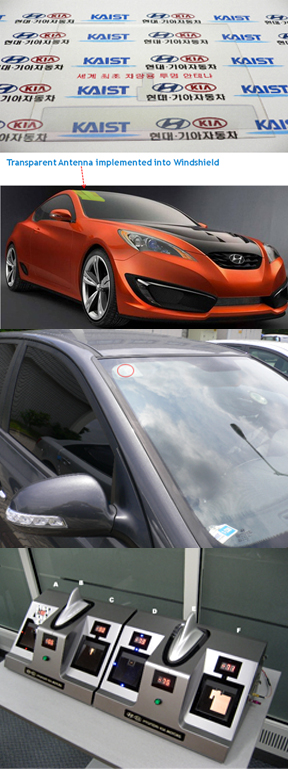 Transparent Antenna for Automobile Developed
A research team led by Prof. Jae-Woo Park of the School of Electrical Engineering & Computer Science, KAIST, developed a transparent antenna for the next-generation automobiles, university authorities said on Monday (Aug. 17).
The development was made possible through joint researches with the Hyundai-Kia Automotive Group; Winncom, a car antenna manufacturer; and a group of researchers led by Han-Ki Kim of the Department of Display Materials Engineering at Kyung Hee University in Seoul.
The transparent antennas were developed in two kinds -- one for the HSDPA (High-Speed Downlink Packet Access), a new protocol for mobile telephone data transmission, and the other for transmitting and receiving radio wave for emergency call.
Using the transparent electrically conductive film formation technology, the transparent antennas are to be mounted on the windshield of a vehicle.
"The development of transparent antenna represents a step forward for the advancement of the next-generation automotive electronic technology," said Seong-woo Kim, a senior researcher at the Hyundai-Kia Group.
2009.08.18 View 16197
Transparent Antenna for Automobile Developed
A research team led by Prof. Jae-Woo Park of the School of Electrical Engineering & Computer Science, KAIST, developed a transparent antenna for the next-generation automobiles, university authorities said on Monday (Aug. 17).
The development was made possible through joint researches with the Hyundai-Kia Automotive Group; Winncom, a car antenna manufacturer; and a group of researchers led by Han-Ki Kim of the Department of Display Materials Engineering at Kyung Hee University in Seoul.
The transparent antennas were developed in two kinds -- one for the HSDPA (High-Speed Downlink Packet Access), a new protocol for mobile telephone data transmission, and the other for transmitting and receiving radio wave for emergency call.
Using the transparent electrically conductive film formation technology, the transparent antennas are to be mounted on the windshield of a vehicle.
"The development of transparent antenna represents a step forward for the advancement of the next-generation automotive electronic technology," said Seong-woo Kim, a senior researcher at the Hyundai-Kia Group.
2009.08.18 View 16197 -
 Jinkon Chung won gold prize at 'Intel student paper contest'
Jinkon Chung won gold prize at ‘Intel student paper contest’
Jinkon Chung, doctorate student at the Division of Electrical Engineering under Professor Yonghoon Lee’s supervisory, won the gold prize at ‘the student paper contest 2006’ organized by Intel Korea.
Chung proposed an important key for the next-generation mobile communication technologies at his paper entitled with ‘Regularized channel diagonalization for multi-user MIMO downlink using a modified MMSE criterion’.
That is a new linear processing algorithm showing superior performances to the existing ZF-based or MMSC-based methods under the circumference of multi-user MIMO, which is the most spotlighted field in the recent next-generation mobile communication technologies, which was highly evaluated in the contest.
Meanwhile, Howon Lee and Sunghoon Lim, Division of Electrical Engineering, also won bronze prizes.
2006.11.27 View 15480
Jinkon Chung won gold prize at 'Intel student paper contest'
Jinkon Chung won gold prize at ‘Intel student paper contest’
Jinkon Chung, doctorate student at the Division of Electrical Engineering under Professor Yonghoon Lee’s supervisory, won the gold prize at ‘the student paper contest 2006’ organized by Intel Korea.
Chung proposed an important key for the next-generation mobile communication technologies at his paper entitled with ‘Regularized channel diagonalization for multi-user MIMO downlink using a modified MMSE criterion’.
That is a new linear processing algorithm showing superior performances to the existing ZF-based or MMSC-based methods under the circumference of multi-user MIMO, which is the most spotlighted field in the recent next-generation mobile communication technologies, which was highly evaluated in the contest.
Meanwhile, Howon Lee and Sunghoon Lim, Division of Electrical Engineering, also won bronze prizes.
2006.11.27 View 15480